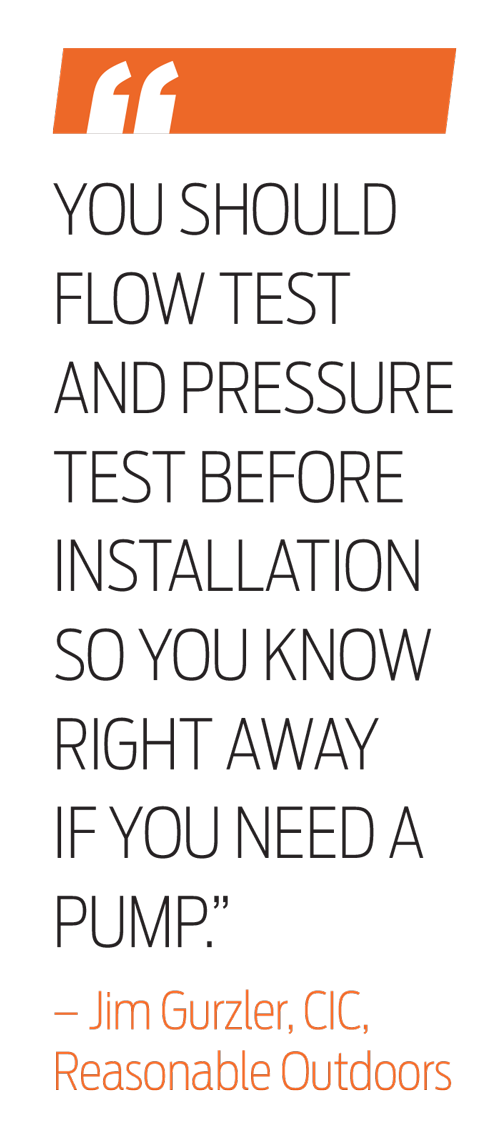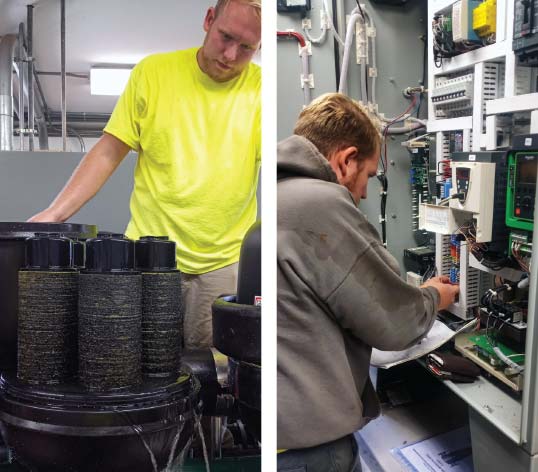With an irrigation system plan design in hand, you’re ready to start digging trenches and putting things into motion. Then, you notice a caveat in the plan’s notes, alerting you to the fact that if the intended water pressure and flow are not met, you’ll need to provide a pump to meet design specifications. But how do you determine if a pump is required? How do you correctly size, place and incorporate a pump into an irrigation system?
Pumps are an integral part of many irrigation systems. Having an understanding of how they operate and how their specifications impact the larger design will determine whether or not those plans come together or if it will turn out to be an installation nightmare. Building around a few easy measurements can make all the difference.
With these simple tips from an irrigation expert, successfully installing a fully functioning and efficient irrigation system while avoiding the most common errors and pitfalls surrounding pumps will be a breeze.
Know your flow
The main purpose of a pump in an irrigation system is to either create pressure from nothing or to boost pressure. A system with low pressure will perform poorly, while a system with too much pressure will be inefficient.
“If pressure is too low, the sprinkler head won’t be able to throw the designed distance, so coverage will be bad,” says Jim Gurzler, CIC, of Reasonable Outdoors in Drums, Pennsylvania. “If the pressure is too high, you’ll see misting from the sprinkler heads, which means your droplet size is too small and you’ll have a lot of drift and potential for waste.”
 In cases where the water is coming from a natural source like a lake or a cistern, using a pump to create pressure is a no-brainer. But most often, a contractor will need to take stock of the water capacity and pressure that’s available, then make a determination.
In cases where the water is coming from a natural source like a lake or a cistern, using a pump to create pressure is a no-brainer. But most often, a contractor will need to take stock of the water capacity and pressure that’s available, then make a determination.
The maximum gallons per minute required to efficiently operate an irrigation system is based on the pressure and the gallons per minute required for your largest zone in the system, Gurzler says. Oftentimes, irrigation plans for new construction are based on the water capacity that the designer anticipates will be available on-site. In those cases, the notes will often include the caveat that a pump may be required to meet design specifications.
“Based on your irrigation system design, you’re looking to meet the pressure requirements after friction loss has been calculated to get your sprinklers or drip irrigation to the desired pressure,” Gurzler says.
Generally, contractors will first install a system as the plans are laid out to determine whether its performance is what it was intended to be. Then they will make the decision to add a pump if the output doesn’t match up to the original expectations. Gurzler says that considering the system flow up front saves time and effort.
“You should flow test and pressure test before installation so you know right away if you need a pump,” he says.
There are a couple different options for determining a system’s water capacity. According to Gurzler, one option is attaching a flow meter to the pipe, opening the pipe and measuring the flow. Another option is the tried-and-true bucket test.
“You would do that with a stopwatch and a bucket or collection vessel to see how many gallons a minute you have coming out of the pipe,” he says.
Right for the job
Pump sizing is based on the specifications set forth in the plan design. If a system design calls for sprinkler heads to operate at 70 psi but it is actually operating at 55 psi, the system needs 15 pounds of boost from a pump. This is often a point of misconception in the industry, Gurzler says. When sizing for a pump, it’s easy to think that because the system needs 70 psi of output, the contractor should just ask the distributor for a 70-psi pump. In the above example, that would be oversizing the pump because it doesn’t take into account the system’s current output.
“You need to know the incoming pressure and the outgoing pressure, then determine the gap,” he says.
Oversizing the pump has a few negative ramifications. First, you’ve spent too much on a pump too big for the job. Second, you could be overpressurizing the system, resulting in wasteful mist. But too much pressure is more than wasteful. It can also wreak havoc on the system’s components.
“If you oversize the pump, the pump is trying to draw too much water into the pipe, which can create cavitation that can damage the pump,” Gurzler says.
Once you select a pump with the right boost and the right gallons per minute, it’s time to select the right motor.
A 115- or 240-volt single-phase power supply is the right choice for residential installations, while a commercial job site might have a 230-volt or 460-volt three-phase power supply. In some cases, a designer may have planned for a three-phase power supply that doesn’t exist on a job site. In that case, a variable frequency drive can transform a single-phase power supply into a three-phase power supply.
“Some commercial sites don’t have a three-phase power source. In that case, you can buy a variable frequency drive that can take single-phase power in and make three-phase power,” Gurzler says. “That’s recommended for commercial customers with a larger pump. The higher the voltage, the more efficient the motor typically is, and the lower the cost of operation.”
It’s also worthwhile to note that while a simple pump start relay is either on or off, you can set the pressure with a variable frequency drive.
“With a variable frequency drive, you set the pressure it runs at, so if you do oversize the pump, you can still set the pressure you want,” Gurzler says.
Choosing the right installation
When it comes to pump installation, there are several factors to take into consideration to provide the right pressure and avoid doing damage to the system. While the designer may envision the pump in one location, and while that location may logistically make the most sense, that decision may need to be revisited at the job site due to aesthetic concerns.
Gurzler recalls one job where the designer was adamant about the location of the pump, which was supposed to be placed right in front of a beautiful building. Realizing it would be a complete eyesore, Gurzler says he contacted the designer to express his concerns. After several calls back and forth, the designer finally agreed to a change order, because in the end, aesthetics are a very important consideration.
Safety is another key consideration when choosing the right location for a pump.
 “You don’t want people touching the pump,” Gurzler says. “It has spinning parts, so you have to consider the location.”
“You don’t want people touching the pump,” Gurzler says. “It has spinning parts, so you have to consider the location.”
Because pumps have to be accessible for service, they can’t be buried. They can’t be in a box below ground level, which could flood, causing damage to the motor.
“Typically, it has to have some kind of shroud around it,” Gurzler says. “There will be some kind of enclosure to prevent vandalism, and to keep the sun, rain and snow from damaging the motor.”
Sometimes, a pump can be installed and secured inside a building, protected from curious hands and nature. In that case, it likely doesn’t need a safety cage surrounding it.
The availability of a power source is the last key concern when choosing where to install a pump.

“Sometimes that may not be the biggest consideration in the design, and you have to bring power to the pump,” Gurzler says.
In situations where power has been overlooked in the planning stages, there is still a fix on the back end. But, that fix is often costly.
“When the available power isn’t what was part of the original plan, it negates the pump design,” Gurzler says. “Maybe the site doesn’t have three-phase power but the designer assumed it did. That can be a problem. You can install a variable frequency drive at the pump, but the drive has to be sized much larger because the amperage is figured on the lower voltage. It’s an expensive oops. There is a large range for the cost of the equipment, but it could be in the thousands of dollars.”
Considering the power source from the outset can also save yourself the hassle of determining who will pay for a costly pump that wasn’t part of the original plan.
“That situation often leaves the irrigation contractor and the client trying to decide who is responsible for paying for the pump,” Gurzler says.
Once a pump is sized, selected and installed, most of the hard work is complete. However, Gurzler recommends regular inspections to make sure all parts are in good working order.
“You should make sure all electrical and mechanical connections are tight, at least annually,” Gurzler says.





